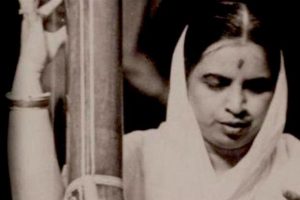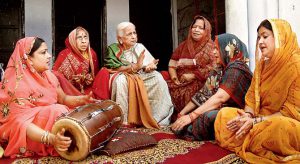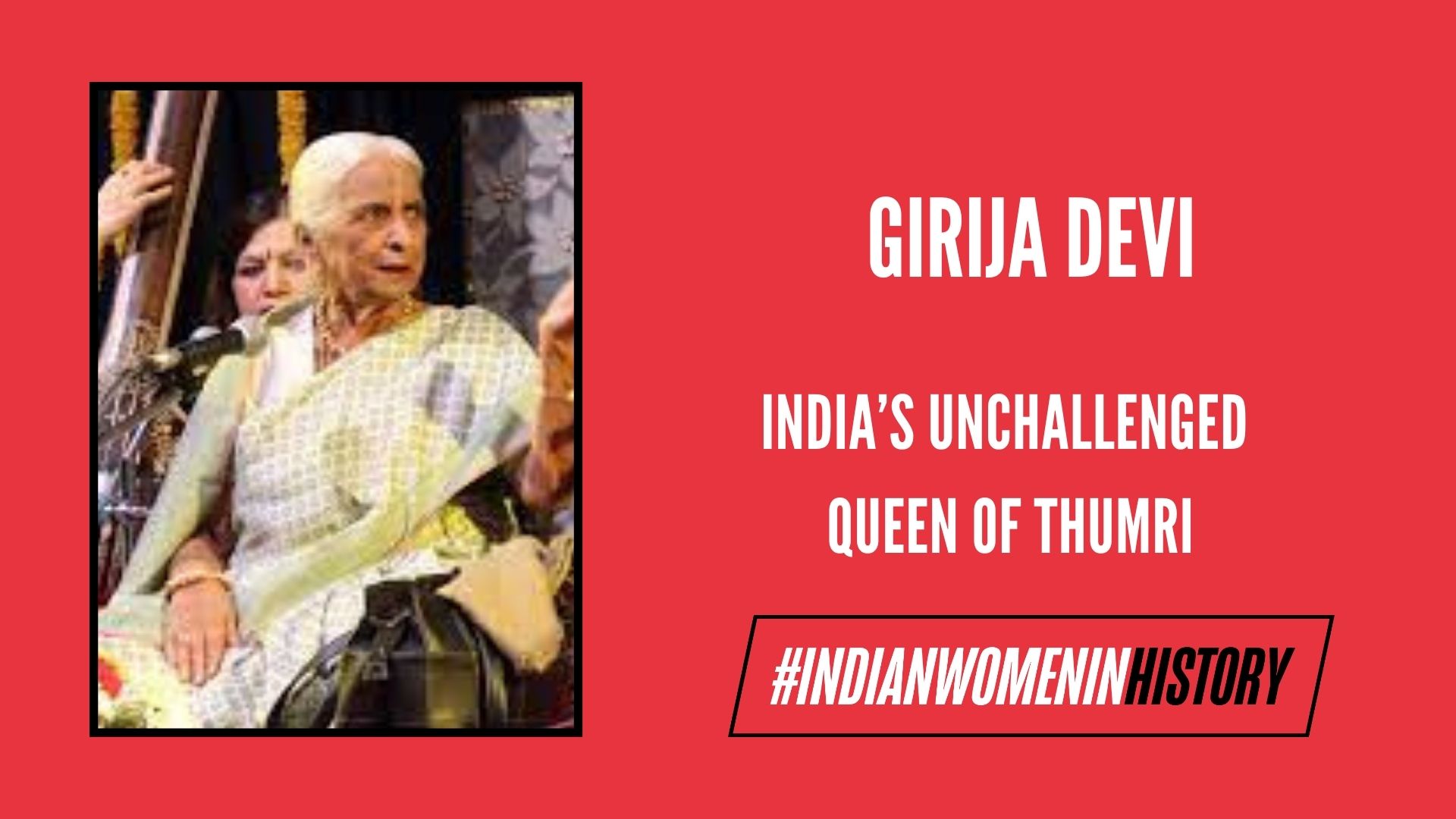To lovers of Hindustani classical music, the name of Girija Devi denotes the acme of perfection in the arena of thumri an intensely popular style of vocal music. Who can forget the famous lyrics Ras Ke Bhare Torey Nain (Your eyes are full of nectar), which she rendered so flawlessly that it instantly touched the listeners’ hearts?
She is a singer nonpareil and till date no other vocalist, no matter how talented, has been able to match her singing skills and the indelible impression which she left in the minds of her listeners. Nonetheless like most of her brethren, she too faced many hurdles while working her way up to the highest echelons. Yes, Girija Devi figures among the much adored luminaries in the firmament of Indian classical music.
Early life
The beginning was innocuous. Girija Devi was born on 8th May 1929 in an archetypal Hindu family in a nondescript north Indian village. She was the youngest of the three daughters of Ramdeo Rai , a Bhumihar zamindar. Two years later the family relocated to Varanasi/Benaras, which became her home for virtually the rest of her life. Being the youngest offspring she was pampered a great deal by her father. He encouraged her to learn fencing and horse riding, which was quite unusual for girls of those times.
Interestingly, Varanasi being a fountainhead of Hindustani Classical music, the little girl was exposed to a good deal of high quality music. Ramdeo Rai himself an ardent music lover, recognised Girija’s passion for singing and made suitable arrangements for her training. However the rest of the family was completely opposed to the idea. As the story goes, her mother who became a great fan of hers in the years to come, was initially flabbergasted as to why Girija was wasting her time and energy on something as immaterial as classical singing.
Also read: Kishori Amonkar: A Rebellious Musician And Fierce Feminist | #IndianWomeninHistory
So little Girija began her music classes at the abode of her guru Pandit Sarju Prasad Misra. His house was located in the Kabir Chaura neighbourhood of Varanasi, where many other famous contemporary musical maestros also resided. This provided the right ambience for her training. Girija learnt diverse classical forms such as Khyaal and Thumri, followed by the more intricate Tappa. After Pt. Prasad’s demise she was tutored by Pt. Shrichand Mishra. In 1939, she got an opportunity to sing at the Congress session in Jabalpur. Her performance was lauded by none other than Mahatma Gandhi. Her first and only brush with the tinsel world was her portrayal of an untouchable girl in the film Yaad Rahe (May it be remembered).
Marriage and after
As was the norm during those days, Girija had barely turned fifteen when she was married off to Madhusudan Jain, a businessman-turned-cultural aficionado. The following year a daughter was born to them. Jain proved to be her patron and guardian angel in the real sense of the term. He extended his help and cooperation to his spouse and helped her juggle home, their baby and music. When she took up a rented accommodation in nearby Sarnath where she could concentrate on her music, he had no qualms about it. Her mother agreed to look after her baby while she would be away.

During her one year sabbatical, Jain accompanied his wife’s Guru and visited her daily. The master chalked out a strict regimen for his disciple, subjecting her to rigorous practice, spanning long hours, day in and day out. In her memoirs, Girija Devi later recalled that her year-long dedicated sadhana proved to be a life changing experience.
Career graph
Her major break came when she had just turned 20. Her first concert was aired from Allahabad radio station in 1949. Her performance at the AIR music conference in 1952, brought her to limelight. She had found success.
Also read: M. S. Subbulakshmi And The Voice That Mesmerized Millions | #IndianWomenInHistory
Thence, there was no looking back. She forged ahead, emerging as the singer with that metallic tinge to her voice, who specialised in thumri. Gradually she managed to carve a niche for herself among stalwarts. During this phase of her career her husband egged her on to travel to various place countrywide, and perform at musical festivals. This indeed was a learning process that enriched her life and art. She worked as a faculty member of the ITC Sangeet Research Academy in Kolkata in the 1980s followed by a similar stint at the Banaras Hindu University during the early 1990s,
after her hiatus, she busied herself with the task of fine-tuning thumri and cleansing it of lewd elements
Tragedy and career revival
In 1975, her husband of 31 years passed away, leaving the chanteuse heartbroken. She quit singing only to find herself enmeshed in domestic strife and hardships. After a hiatus of nearly a year, Girija Devi, cajoled by friends and loved ones, determined to resume her public performances. However a change was palpable in her renditions. She had all along been associated with the Purab Ang style of thumri. But after her hiatus, she busied herself with the task of fine-tuning thumri and cleansing it of lewd elements. She infused a devotional and prayerful mode into her gayaki .

Many of these pieces were dedicated to Lord Krishna, the blue-hued cowherd deity. At this juncture, Girija Devi also decided to plumb the depths of Rasa –an essential ingredient inherent in music, literature and fine arts. She focused on the display of emotions through vocal music. In particular, she explored the entire gamut of love – divine, maternal or interpersonal. The end result of her experiments and innovations was that thumri got a facelift and lost its earlier contour. Alongside she dabbled in other musical forms clubbed under Banarasigenre – dadra, holi, chaiti, jhoola et al. Unfortunately for her, her well crafted renditions in khayal failed to evoke heartwarming response from the listeners.
Girija Devi in real life
Following her husband’s demise, Girija Devi permanently moved in with her only daughter Sudha Datta and decided to stay put in her favourite Varanasi. Datta has profusely written about her mother and recorded very many incidents and anecdotes which provide the readers an insight into her personal life. During her long musical journey she fostered close friendships with famous musical personalities – from Pt Ravi Shankar and Ustad Ali Akbar Khan to Pt Bhimsen Joshi and the Mangeshkar siblings.

These ties ended only with her death. Apparently, she was an avid movie fan with a penchant for light-hearted flicks. The violence and cruelty depicted in many films would frighten her no end. Her daughter also divulges that when Girija Devi was not performing or doing riyaz she would be busy dishing up delicacies to feed team members and close associates. It is widely known that she was a strict disciplinarian. That is possibly the secret behind her long life. She literally died with her boots on. In the evening preceding her death, she was a visible bundle of energy, while performing at the Sangeet Research Academy in Kolkata.
Even In the evening preceding her death, she was a visible bundle of energy, while performing at the Sangeet Research Academy in Kolkata.
Perpetual romance with Varanasi & Ganga
Since Girija Devi arrived in Varanasi as a two year old, the city virtually became her lifeline, her raison d’être. She believed there was eternal quality about Varanasi, hailed as the oldest living city in the world. Varanasi – a melting pot for divergent currents and cross currents of faith cultures and ethos, fascinated her no end. She was also mesmerised by the River Ganga which occupies a pride of place in Hindu faith scriptures and traditions. The vocalist harboured a treasure trove of memories linked to the sacred river – swimming in its waters, fishing and playing on its banks during her childhood!
Awards and accolades
Girija Devi was bestowed the Padma Shri for her contribution to music way back in 1972.This was followed by Padma Bhushan in 1989 and finally the Padma Vibhushan in 2016, just a year prior to her death.

Bidding adieu
On 24th October 2017, she died in an upmarket hospital in Kolkata following a cardiac arrest. With her passing, the legendary voice was hushed forever. All in all, the River Ganga remained the most prominent motif in her life. She grew up and spent her entire life beside the river in her home town. It is somewhat uncannily that she breathed her last, again by the side of her favourite Ganga, though in an alien city!
References
About the author(s)
Delhi based Ruchira Ghosh is a trained journalist with nearly two & a half decade’s writing experience and exposure to print, web and television.




